Celtic Cross Spread
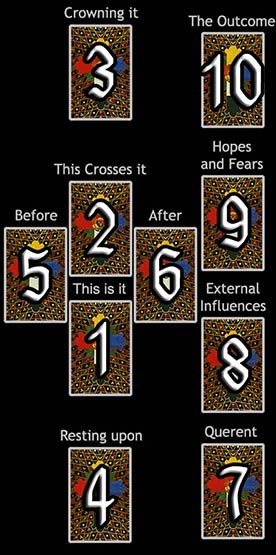
Difficulty: Average
This is probably the most well-known tarot spread. A good, basic spread for beginners to practise with, the Celtic Cross is useful for questions of all types. In this spread, it can be helpful to notice the relationships between the pairings of cards #5 & #9, #1 & #2, #3 & #4, and #6 & #10.
- The significator epitomizes what the reading deals with, the initial situation.
- An added impulse that compounds the significator, which may be either complimentary or contradictory.
- This is what is consciously known (thoughts).
- Unconscious driving forces that may not be known fully (emotions).
- The immediate past regarding the current situation.
- The first future card indicates the immediate future.
- This card represents the reader and their attitude towards cards #1 and #2.
- The external influences, the places and people which influence the topic.
- This tarot card suggests expectations; what is secretly hoped for or feared.
- The second future card reveals the long-term outcome.
Your Celtic Cross Reading
The Crown |
The Outcome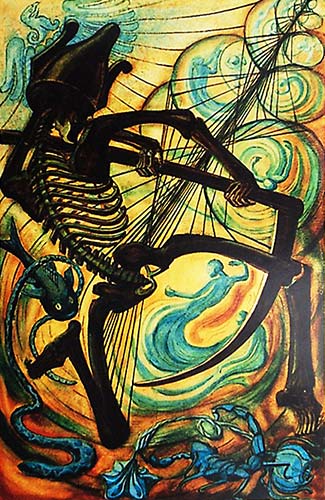 XIII – Death
External Forces 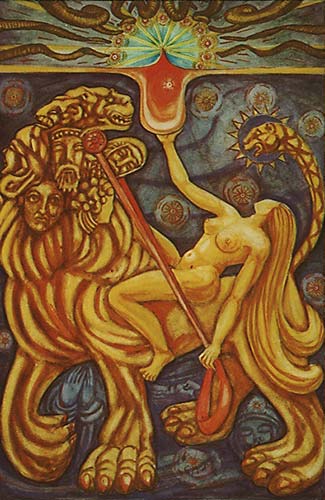 XI – Lust
|
||
The Recent Past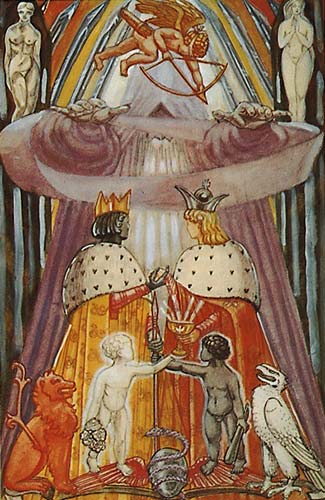 VI – The Lovers |
The Crossing Card
|
The Future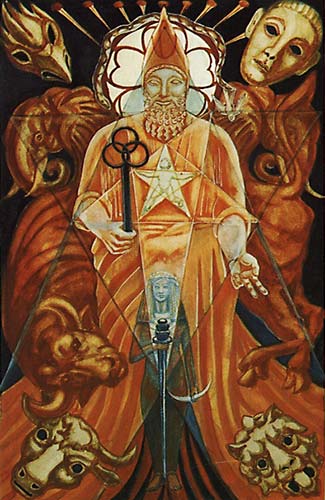 V – The Hierophant |
|
|
|||
The Significator represents what the main theme of the reading deals with, the initial situation.
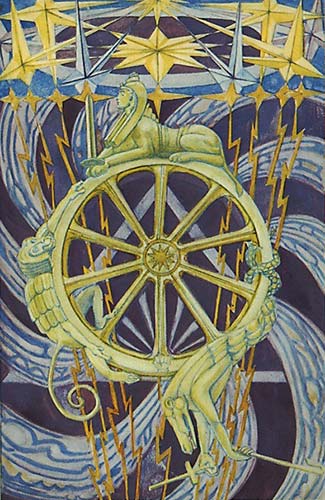
X – Fortune
(Jupiter, Kaph)
Fortune represents the ever-turning wheel of fate, symbolising the cycles of change and the opportunities that arise through the interplay of forces. Associated with Kaph, the palm of the hand, this card signifies the ability to grasp the turning tides of fortune and shape one's destiny. Jupiter, the planet of expansion and abundance, imbues the card with optimism and growth.
The Wheel of Fortune is depicted as a cosmic mechanism, a rotating mandala of symbols and figures. At its centre is the ten-spoked wheel, representing the cyclical nature of existence and integration of opposites. Around it spin the Sphinx, the serpent, and the baboon, embodying stability, transformation, and the playful chaos of change. The wheel is connected to its spiritual counterpart above, signifying the promise of renewal and the unity of all things within the cosmic dance.
In Relationships: Fortune suggests change and new opportunities. It encourages you to embrace the unpredictable nature of love and remain open to its possibilities.
In Work: This card signifies a turning point and the potential for unexpected success. You are advised to seize opportunities and trust in the benevolent forces of change.
Spiritually: Fortune represents the acceptance of life's cycles and the wisdom gained through change. It calls you to embrace the flow of the universe and find peace in its rhythms.
When ill-dignified: Fortune warns of resistance to change, missed opportunities, or the chaotic forces of upheaval. You are advised to trust in the process of transformation and remain adaptable in the face of uncertainty.
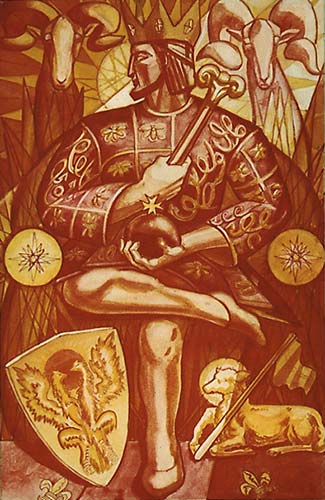
The Crossing Card denotes an added impulse that compounds the initial card, whether complimentary or contradictory.
IV – The Emperor
(Aries, Tzaddi)
The Emperor represents the force of order, authority, and structure, embodying the disciplined energy required to manifest power and stability in the material world. He is linked to Tzaddi, symbolising insight and vision, representing the ability to perceive higher truths and take decisive action in alignment with divine will. As the astrological ruler Aries, he brings fiery determination and a pioneering spirit.
The Emperor sits on a ram-adorned throne, a clear nod to Aries, surrounded by a vibrant red background that speaks of his dynamic energy and martial authority. His sceptre, along with the orb and cross, symbolises the dominion of spirit over matter. At his feet lies the double eagle shield, representing far-reaching vision and the ability to soar above obstacles. The geometric forms surrounding him suggest the stability of order, while the lamb beneath his throne reminds us of the balance between power and protection.
In Relationships: The Emperor indicates a relationship rooted in stability, leadership, and mutual respect. It calls for clarity, honesty, and the willingness to establish healthy boundaries and foundations.
In Work: This card represents mastery over the material realm and the ability to build structures that endure. It encourages you to take charge of your destiny confidently and lead by example.
Spiritually: The Emperor signifies the grounding of spiritual energy into practical action. He calls you to embody your highest ideals in your daily life, manifesting divine will through disciplined effort.
When ill-dignified: The Emperor warns of rigidity, authoritarianism, or a misuse of power. You are cautioned to balance control with flexibility and lead with wisdom rather than dominance.
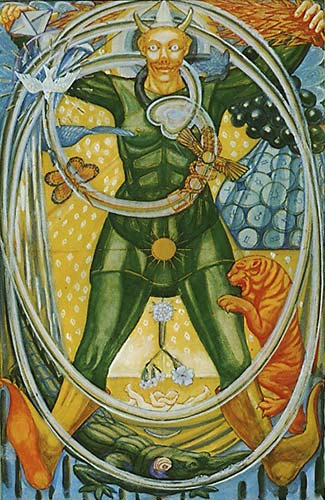
The Crown stands for what the asker is aware of consciously.
0 – The Fool
(Air, Uranus, Aleph)
The Fool of the Thoth deck embodies the chaotic, boundless energy of pure potential, untouched by form or limitation. He is the alpha and omega of the journey, the primordial force from which all creation arises. Corresponding to Aleph, the breath of life, and the element of Air, the Fool represents the vibrant, unpredictable nature of Uranus, the planet of sudden change and divine inspiration.
The figure of The Fool is richly adorned, standing amid a swirling maelstrom of symbolic forms. He wears motley robes to represent his openness to all experiences, while the winged sun at his feet symbolises the life-giving power of the divine. Around him whirl a tiger (representing instinct and primal fear), a crocodile (a guardian of the mysteries and a symbol of time), and a rainbow-hued disk, representing the harmony of all elements. The Fool holds a blazing torch in one hand and a crystal cup in the other, signifying the balance of will and receptivity. One foot is grounded in the world, while the other stands on the fourth wall, as if attempting to step into our world.
In Relationships: The Fool represents the potential for new beginnings and uncharted emotional experiences. It encourages you to approach relationships with innocence and trust, unburdened by fears or preconceptions.
In Work: This card advises bold action and faith in one's ideas. It suggests venturing into unfamiliar territory and taking inspired risks, understanding that growth lies in embracing uncertainty.
Spiritually: The Fool symbolises the seeker's initial step on the path to enlightenment, an act of surrender to the cosmic current. It urges you to trust the process and let go of the need for certainty.
When ill-dignified: The Fool warns of chaos, recklessness, or naivety. You are cautioned to discern whether you are pursuing freedom or fleeing responsibility and examine whether your actions align with higher wisdom.
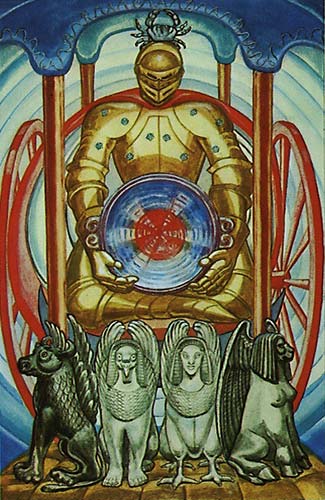
Foundation card reveals unconscious driving forces that the querent may not be aware of.
VII – The Chariot
(Cancer, Cheth)
The Chariot represents triumph through willpower, discipline, and the unification of opposing forces. Associated with Cheth, the fence, it symbolises both protection and the boundaries that define and direct progress. Cancer, the zodiac sign of emotional depth and intuition lends the card its nurturing energy, ensuring that strength is tempered with compassion.
The Charioteer is a figure of regal composure, encased in golden armour and standing within a shell-like chariot. This shell evokes the protective qualities of Cancer, while the armour signifies spiritual and emotional fortitude. In his hands, he holds the Holy Grail, a symbol of divine purpose and spiritual attainment. The four sphinxes that draw the chariot—two white and two dark—represent the dual forces of light and darkness, which the Charioteer must master to move forward. The canopy above him is adorned with stars, linking his journey to celestial guidance and higher aspirations.
In Relationships: The Chariot indicates a relationship that requires balance and mutual effort to succeed. It suggests overcoming obstacles through shared determination and a focus on common goals.
In Work: This card signifies victory achieved through discipline, focus, and the ability to steer conflicting forces towards a unified purpose. You are encouraged to remain steadfast and clear in your intentions.
Spiritually: The Chariot represents the journey of the soul towards higher awareness, guided by the alignment of will and intuition. It calls you to embrace your inner strength and move forward confidently.
When ill-dignified: The Chariot warns of a loss of direction, internal conflict, or reckless ambition. You are advised to reassess your goals and ensure you are not being led astray by conflicting desires or external pressures.

The Recent Past represents past events and concerns.
VI – The Lovers
(Gemini, Zain)
The Lovers represent the alchemical union of opposites, a card rich with symbolism of choice, harmony, and divine love. Associated with Zain, the sword, this card represents the piercing clarity needed to discern and unite polarities. Gemini, the zodiac of duality and communication, imbues it with the energy of connection and synthesis.
The Thoth Lovers card depicts the union of the royal figures of Sol and Luna under the guidance of a cupid-like angel. Below them, the Orphic egg is encircled by the serpent, symbolising potential and cosmic rebirth. The figures are surrounded by the emblems of alchemical transformation: fire and water, masculine and feminine, light and shadow. The imagery suggests not only romantic love but also the integration of the conscious and unconscious mind, as in shadow work.
In Relationships: The Lovers signify connection, mutual respect, and the merging of hearts and minds. It also emphasises the importance of choice and the conscious commitment to love and partnership.
In Work: This card suggests collaboration and harmonising diverse forces to achieve a greater goal. It encourages you to seek partnerships that align with your values and vision.
Spiritually: The Lovers represent the union of opposites within the self, a crucial step on the path to enlightenment. It calls you to embrace your inner dualities and find harmony through integration.
When ill-dignified: The Lovers caution against indecision, misaligned partnerships, or superficial connections. You are urged to examine whether you are avoiding responsibility or compromising your truth for the sake of harmony.

The Future depicts that which lies ahead.
IV – The Emperor
(Aries, Tzaddi)
The Emperor represents the force of order, authority, and structure, embodying the disciplined energy required to manifest power and stability in the material world. He is linked to Tzaddi, symbolising insight and vision, representing the ability to perceive higher truths and take decisive action in alignment with divine will. As the astrological ruler Aries, he brings fiery determination and a pioneering spirit.
The Emperor sits on a ram-adorned throne, a clear nod to Aries, surrounded by a vibrant red background that speaks of his dynamic energy and martial authority. His sceptre, along with the orb and cross, symbolises the dominion of spirit over matter. At his feet lies the double eagle shield, representing far-reaching vision and the ability to soar above obstacles. The geometric forms surrounding him suggest the stability of order, while the lamb beneath his throne reminds us of the balance between power and protection.
In Relationships: The Emperor indicates a relationship rooted in stability, leadership, and mutual respect. It calls for clarity, honesty, and the willingness to establish healthy boundaries and foundations.
In Work: This card represents mastery over the material realm and the ability to build structures that endure. It encourages you to take charge of your destiny confidently and lead by example.
Spiritually: The Emperor signifies the grounding of spiritual energy into practical action. He calls you to embody your highest ideals in your daily life, manifesting divine will through disciplined effort.
When ill-dignified: The Emperor warns of rigidity, authoritarianism, or a misuse of power. You are cautioned to balance control with flexibility and lead with wisdom rather than dominance.

The Querent represents the asker and their attitude towards the subject of the reading.
XX – The Aeon
(Judgement, Fire, Shin)
The Aeon represents transformation, evolution, and the awakening to a higher state of consciousness. Associated with Shin, the tooth, this card reflects the process of breaking through old paradigms to embrace a new spiritual era. Crowley's reinterpretation of Judgement as The Aeon emphasises rebirth on a cosmic scale, rather than individual reckoning.
The central figure is the translucent child-god Horus, representing the dawn of a new age. Above him, Nuit, the goddess of infinite space, arches across the sky, and Hadit, the fiery point of divine inspiration, burns at her core. The two incarnations of the same figure symbolise the transition from the old to the new. The vibrant reds and blues throughout the card evoke the dynamic forces of destruction and creation.
In Relationships: The Aeon signifies the potential for profound change. It suggests leaving behind outdated patterns and embracing a higher level of connection and understanding.
In Work: This card indicates a turning point, calling you to align with your true purpose and embrace transformative opportunities.
Spiritually: The Aeon symbolises awakening to a higher state of being. It calls you to release the past and step into your divine purpose with courage and clarity.
When ill-dignified: The Aeon warns of resistance to change, clinging to outdated beliefs, or fear of transformation. You are advised to trust the process of renewal and embrace the potential of the new era.

External Forces represents the influence of others in your life as well as trends in your relationships with others.
XI – Lust
(Leo, Teth)
Lust, known as Strength in many other decks, takes on a unique and profound meaning in the Book of Thoth. This card signifies the ecstatic embrace of life's passions and the power derived from uniting primal instincts with spiritual purpose. Associated with Teth, the serpent, it symbolises both the kundalini energy and the continuous cycles of transformation and renewal. Leo, the zodiac of courage and vitality, infuses the card with boundless confidence and creative expression.
The central figure is a woman riding a multi-headed beast, a symbol of primal forces mastered and directed towards a higher purpose. Her nudity represents authenticity and fearlessness, while the cup she holds aloft is the Holy Grail, symbolising the ultimate spiritual goal. The beast itself, covered in fiery hues, represents the dynamic power of creation, destruction, and renewal. The background is filled with swirling red and gold, reflecting the intensity of life force and divine energy.
In Relationships: Lust represents passion, desire, and a fearless embrace of emotional intensity. It encourages you to fully engage with your relationships, revelling in love's transformative power.
In Work: This card signifies success achieved through boldness, enthusiasm, and a connection to one's creative instincts. You are advised to channel your energy into projects that ignite your passion.
Spiritually: Lust symbolises the awakening of spiritual vitality and integrating one's primal and divine natures. It calls you to surrender to the ecstatic flow of universal energy.
When ill-dignified: Lust warns of unchecked desires, destructive passions, or an overindulgence in material pleasures. You are advised to restore balance and align your desires with a higher purpose.
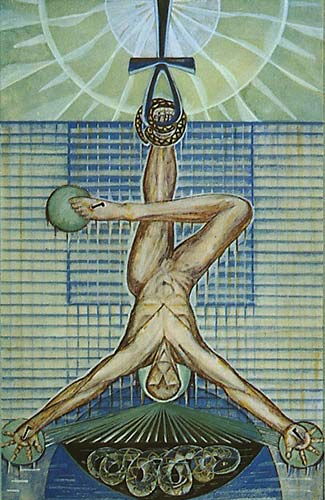
Hopes and Fears shows the expectations you have concerning the outcome of your question.
XII – The Hanged Man
(Water, Mem)
The Hanged Man represents surrender, transformation, and the wisdom gained through self-sacrifice. Associated with Mem, the waters, this card embodies the flow of unconscious depths and the mysteries that lie beyond the material world. It is not a card of suffering but one of enlightenment through letting go.
The central figure is suspended upside-down, forming a cross with his legs, a symbol of balance and sacrifice. His arms form a triangle, evoking the union of spirit and matter. Behind him, the swirling blue-green background suggests the ocean of the subconscious. The serene expression on his face reflects the tranquillity found in surrendering to a greater truth. Around him, rays of light emanate, signifying the revelation that arises from this state of suspension.
In Relationships: The Hanged Man suggests a need for patience, selflessness, and understanding. It encourages you to see things from your partner's perspective and release control.
In Work: This card indicates a period of pause or sacrifice, where immediate goals may need to be set aside for long-term growth. You are advised to trust in the process and focus on the bigger picture.
Spiritually: The Hanged Man symbolises enlightenment achieved through surrender and the release of ego. It calls you to embrace the transformative power of stillness and contemplation.
When ill-dignified: The Hanged Man warns of stagnation, resistance to change, or clinging to outdated beliefs. You are advised to let go of what no longer serves you and embrace the wisdom of surrender.

The Outcome of your question. Interpret this card in the context of the entire reading and as an indicator of the path you are currently on, but not necessarily bound to.
XIII – Death
(Scorpio, Nun)
Death represents transformation, endings, and the profound renewal that arises from letting go. Associated with Nun, the fish, this card symbolises the regenerative cycles of life and the eternal flow of existence. Scorpio, the zodiac of intensity and rebirth, infuses the card with themes of metamorphosis and profound emotional depth.
The figure of Death is a skeletal figure wielding a scythe, harvesting the forms of life to make way for growth. Surrounding him are figures dissolving and reforming, emphasising the continual cycle of destruction and creation. Fish swim in the background, symbolising the life force that persists through change. The overall imagery is dynamic and alive, with a swirling interplay of light and shadow reflecting the transformative energy of this card.
In Relationships: Death signifies the end of a relationship or the transformation of its dynamics. It encourages you to release what no longer serves you, allowing space for growth.
In Work: This card indicates a major transition or the end of a phase. You are advised to embrace change and view endings as opportunities for renewal.
Spiritually: Death symbolises the shedding of old identities and the rebirth of the soul. It calls you to embrace transformation and trust in the process of spiritual evolution.
When ill-dignified: Death warns of resistance to change, fear of endings, or an inability to move forward. You are advised to confront your fears and trust in the natural cycles of transformation.